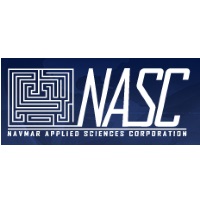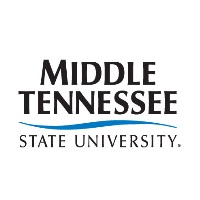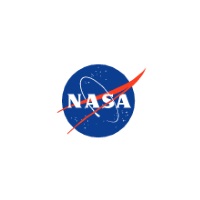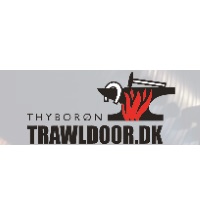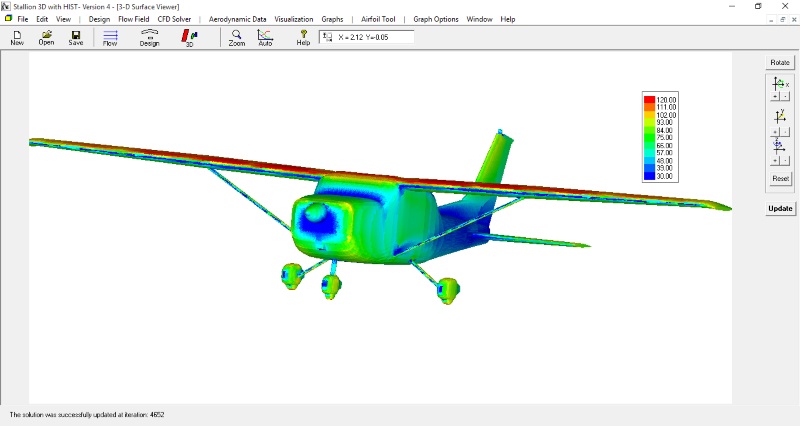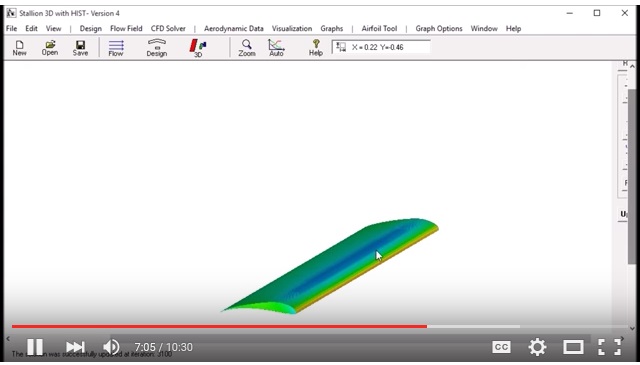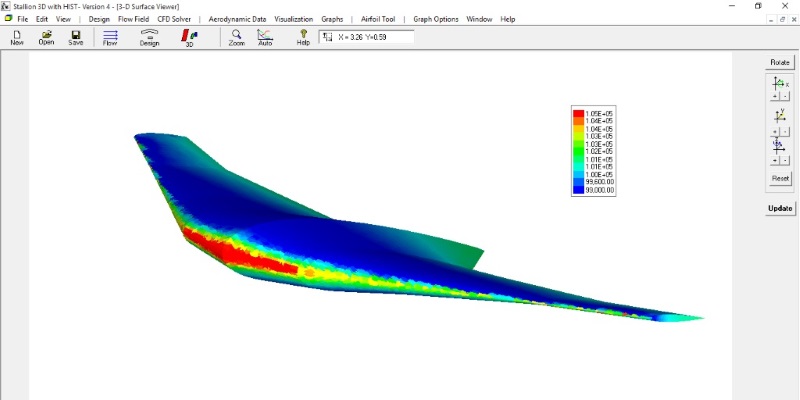Accelerate your subsonic, transonic & supersonic aerodynamic simulations
Validate aerodynamic designs quickly & accurately on Windows 11, 10 & 7.
Stallion 3D was specifically developed to help you create superior aerodynamic designs in the shortest possible time. It validates your complex aerodynamic designs using its built-in high fidelity CFD algorithms. Stallion 3D imports your actual design and automatically generates the volume grid for a quick and accurate RANS analysis. Stallion 3D fills the gaps between low accuracy vorticity flow solvers and expensive HPC & cloud based CFD software. It makes CFD simulations accessible. Stallion 3D is the only aerodynamic software tool that has the knowledge base required to ensure your success. Watch above video for a quick overview 📺
Subscribe for 3 months
Price $895 USD
Buy >
Subscribe for one year
Price $2,895 USD
Buy >
Buy Perpetual Licence
Price $8,995 USD
Buy >
📞 Please call or text us at (352) 653-0875 for more information.
Setup & start your aerodynamics simulation in minutes
Gain valuable insights about your design during the aerodynamic simulation
Setup your CFD simulation in minutes using the built-in design tools:
- Import your actual design, as a STL file, from NASA OpenVSP or your favorite CAD package
- Design wings and aerodynamic surfaces using the extensive airfoil database
- Automatically generate the volume grid and start the solution process
Run the simulation at your desired resolution on your laptop or desktop computer
- Stallion 3D accurately solves your design using RANS for subsonic, transonic and supersonic flows
- The k-epsilon turbulent model is used for realistic flow simulation at any angle of attack (0 to 360 degrees) and any cross flow angle (0 to 360 degrees)
- A flux vector splitting scheme sharply captures shock waves & expedites the compressible flow solution
- Actuator discs (up to 100) are used to model jet, prop wash and other propulsion effects (available in the RANS solver)
- Apply a quasi-steady surface rotation (in any direction and speed) to compute stability derivatives and other special flow effects (e.g. a rotating sphere or cylinder).
- Stallion 3D has optional solvers for Laminar Navier-Stokes & 3D compressible inviscid flows
Interactively review your results during the solution process
- Reports of CL, CD, CM, and related forces and moments coefficients in the coordinates directions
- Reports of lift, drag, yaw, roll, pitch magnitudes and related forces and moments in the coordinates direction
- Plots of pressure, Mach number, velocity, density and temperature on the STL surfaces as a contour color plot
- Plots of pressure, Mach number, velocity, density and temperature at constant coordinate slices in the flow field
- Plots of 2D line graphs of Cp, velocity, mach number, density and temperature at constant coordinates locations long the STL surface (for example, you can plot Cp (x) at any span location along the wing)
- Graphs of streamlines (originating at any location in the flow) using arbitrary colors or using colors designated by the local flow pressure, velocity, density, temperature or Mach number
Even More Benefits!
- SameDayCFD: Fast multiple core CFD analysis on your MS Windows laptop or desktop.
- Install and Run Stallion 3D on Any of Your Computers using the same password.
- No hidden cloud costs! All computations are performed & stored on your computer.
Setup your CFD simulation in minutes using the built-in design tools:
- Import your actual design, as a STL file, from NASA OpenVSP or your favorite CAD package
- Design wings and aerodynamic surfaces using the extensive airfoil database
- Automatically generate the volume grid and start the solution process
Run the simulation at your desired resolution on your laptop or desktop computer
- Stallion 3D accurately solves your design using RANS for subsonic, transonic and supersonic flows
- The k-epsilon turbulent model is used for realistic flow simulation at any angle of attack (0 to 360 degrees) and any cross flow angle (0 to 360 degrees)
- A flux vector splitting scheme sharply captures shock waves & expedites the compressible flow solution
- Actuator discs (up to 100) are used to model jet, prop wash and other propulsion effects (available in the RANS solver)
- Apply a quasi-steady surface rotation (in any direction and speed) to compute stability derivatives and other special flow effects (e.g. a rotating sphere or cylinder).
- Stallion 3D has optional solvers for Laminar Navier-Stokes & 3D compressible inviscid flows
Interactively review your results during the solution process
- Reports of CL, CD, CM, and related forces and moments coefficients in the coordinates directions
- Reports of lift, drag, yaw, roll, pitch magnitudes and related forces and moments in the coordinates direction
- Plots of pressure, Mach number, velocity, density and temperature on the STL surfaces as a contour color plot
- Plots of pressure, Mach number, velocity, density and temperature at constant coordinate slices in the flow field
- Plots of 2D line graphs of Cp, velocity, mach number, density and temperature at constant coordinates locations long the STL surface (for example, you can plot Cp (x) at any span location along the wing)
- Graphs of streamlines (originating at any location in the flow) using arbitrary colors or using colors designated by the local flow pressure, velocity, density, temperature or Mach number
Even More Benefits!
- SameDayCFD: Fast multiple core CFD analysis on your MS Windows laptop or desktop.
- Install and Run Stallion 3D on Any of Your Computers using the same password.
- No hidden cloud costs! All computations are performed & stored on your computer.
Remember the Stallion 3D 5.0 work flow: Setup in seconds
STL file input. No Geometry de-featuring. No user grid generation!
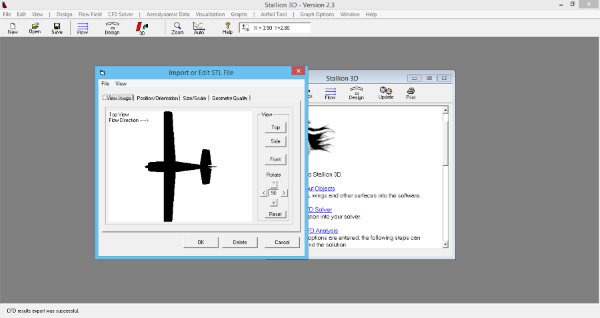
Import the geometry
Set the flow conditions
Setup the CFD
Simulate & review results
Stallion 3D gets real world results
Proprietary algorithm, HIST, computes accurate solutions
Cars and automotive drag prediction

The DrivAer experiment is a validation exercise for CFD solutions of passenger cars. The picture shows the flow velocity near the surface of the DrivAer model with mirrors and detailed under body. The problem was analyzed in Stallion 3D using 1.7 million cell and the RANS/k-epsilon solver. The solution was unsteady with an average drag coefficient of about 0.29.
Supersonic aircraft simulation
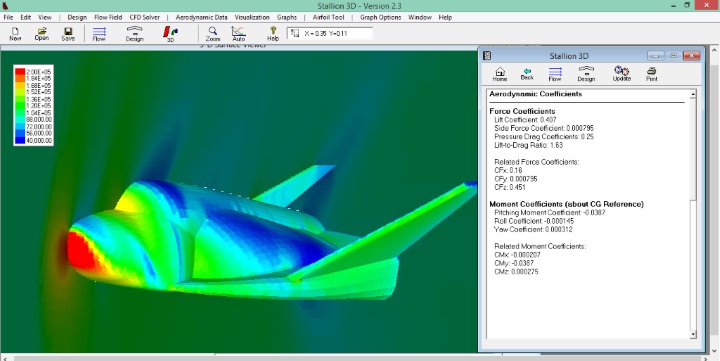
The results from Stallion 3D 5.0 RANS solver (CL = 0.41, CD = 0.25 & CM = -0.0387 ) were compared to the findings of NASA Technical Memorandum 4117,Transonic Aerodynamic Characteristics of a Proposed Assured Crew Return Capability (ACRC) Lifting-Body Configuration by George M. Ware. From the graphs, the corresponding experimental results were (CL = 0.48, CD = 0.24 & CM = -0.042). The geometry was obtained from NASA OpenVSP. The flow parameters for this case are M = 1.2 with an angle of attack of 12 degrees. This simulation used about 480,000 cells and ran for 3 hours on a 2 GHz laptop computer.
Transonic aerodynamics
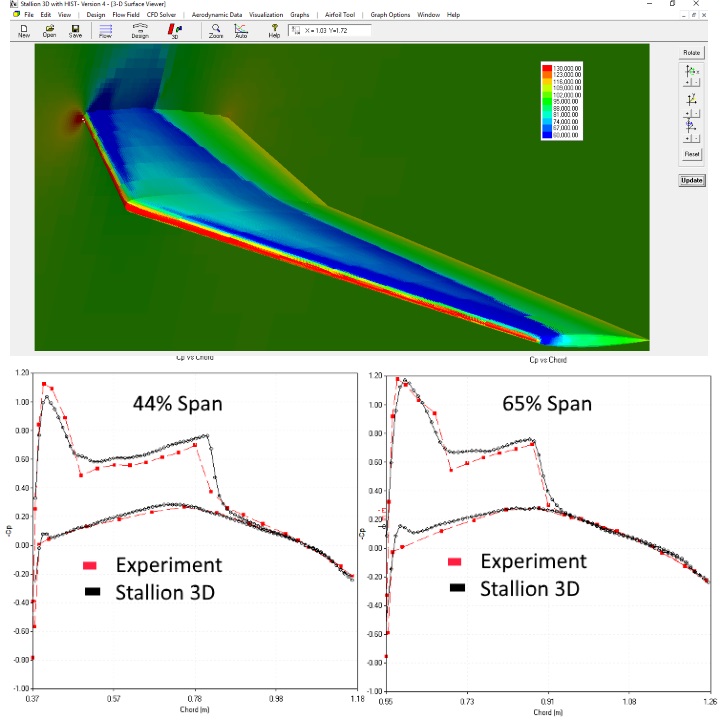
Stallion 3D used the August, 2016 implementation of its RANS/k-epsilon solver for this analysis the ONERA M-6 wing. The CAD model was obtained from NASA OpenVSP hangar. The simulation was setup for the well know case of M=0.84 and an angle of attack of 3.06 degrees. This case used a grid of 447,640 cells and ran for 6 hours on a 2 GHz laptop computer with 4 cores. The picture shows the pressure on the wing along with comparisons of the computed CP versus the experimental data at 2 stations along the wing. Since no experimental values of CL and CD were found, the lift and drag coefficients were compared to results from NASA's CFL3D (Spalart-Allmaras model).
NASA CFL3D |
Stallion 3D |
% Difference |
|
| CL | 0.2754 | 0.275 | 0.145% |
| CD_SkinFriction | 0.00567 | 0.00483 | 14.81% |
| CD_Pressure | 0.01348 | 0.014 | -3.858% |
| CD_Total | 0.01914 | 0.0188 | 1.776% |
Learn how to use Stallion 3D
Follow these instructions to get started in just minutes.
Learn how to simulate a light airplane aerodynamics
Click here to learn the exact steps needed to analyze a Cessna 182 aircraft using Stallion 3D.
Learn how to analyze a race car wing
Click here to watch the exact steps needed to design and analyze a rear wing spoiler for a sports car using Stallion 3D.
Learn how to simulate a subsonic or supersonic BWB
Click here to learn the exact steps needed to analyze a blended wing body (BWB) using Stallion 3D.
Stallion 3D requires a PC, Laptop or tablet running MS Windows 7, 10 or 11.
Subscribe for 3 months
Price $895 USD
Buy >
Subscribe for one year
Price $2,895 USD
Buy >
Buy Perpetual Licence
Price $8,995 USD
Buy >
📞 Please call or text us at (352) 653-0875 for more information.
Stallion 3D Customers
The following organizations use Stallion 3D for education, research & design.
